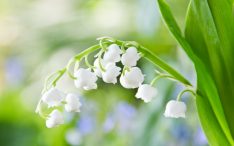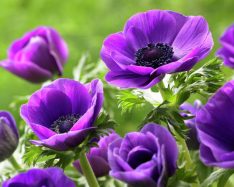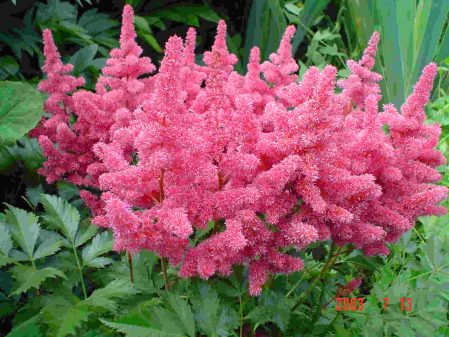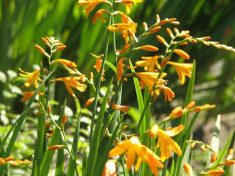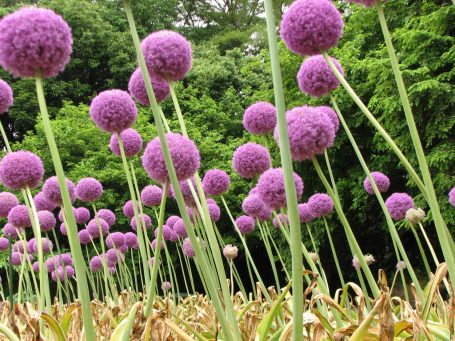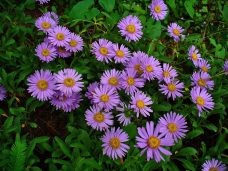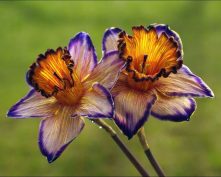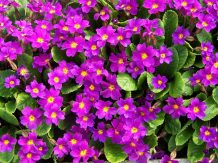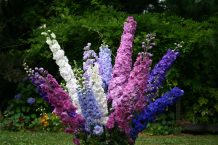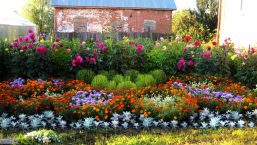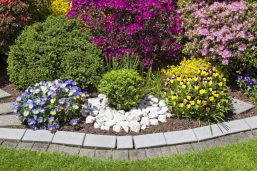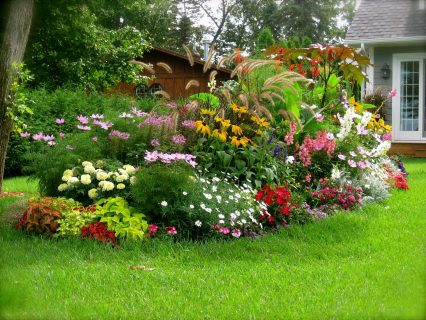Herbaceous perennials are flowering or ornamental deciduous plants. The aerial parts of most of them in a temperate climate appear in April and are developing rapidly. Popular flowers perennials for the garden - unpretentious, long-flowering - enter the budding phase early and delight with a decorative look from spring to autumn.
Material Content:
- 1 Blooming unpretentious perennials for sunny places
- 2 Shady Perennials
- 3 Ground cover perennials
- 4 Bulb flowers
- 5 Variety of colors of perennials depending on size
- 6 Plants for spring planting
- 7 Summer and beautiful
- 8 Perennials for planting in the fall
- 9 Spicy aromatic unpretentious flowers for a summer residence
Blooming unpretentious perennials for sunny places
There are at least two options for preserving the decorative appearance of flower beds until late autumn. The first is the planting of perennials in which flowering lasts a long time. This is a difficult task because there are relatively few such plants.
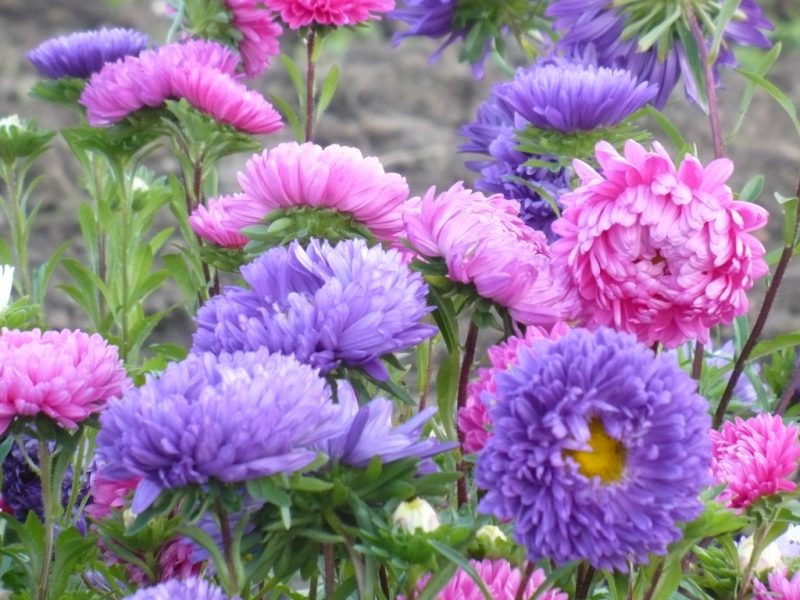
The second option is to select species and varieties of perennials of different flowering periods. This way provides not only the decorativeness of the flowerbed, but also makes it possible to obtain a variety of material for bouquets and floral arrangements within 2-3 months.
Open, well-lit places are needed:
- asters perennial and annual;
- decorative bows;
- gladiolus;
- daylilies;
- tulips;
- gaillardia;
- peonies and others
Light-loving species resistant to a lack of moisture, which invariably occurs with an excess of insolation, are suitable for landing in a well-lit area.
Spring is the time of bulb plants. Phloxes, nyvyaniks, asters are beautiful perennial flowers that look decorative all summer. Unpretentious plants feel good in the lighted area and in partial shade, get along well with neighbors in the flower bed. In anticipation of autumn, the time comes for chrysanthemums.
Photophilous, but not drought-resistant species are best planted on the open shores of natural and artificial reservoirs. A good choice for such sites is hybrid forget-me-nots. This is a herbaceous perennial with a height of 15 to 30 cm with blue petals and a yellow "eye" in the center. Forget-me-not flowering lasts from May to October.
When creating a flower bed from flowering perennials, it should be borne in mind that their decorative value usually occurs in the second or third year of life, and lasts up to 4-5 years (for peonies - 10-15 years).
Shady Perennials
Such plants have enough light penetrating through the crown of trees and shrubs. Also, this group of perennials is planted in areas lit only a few hours a day.
Flowering shade-tolerant and shade-tolerant perennials:
- aquilegia;
- astilbe;
- a center;
- lily of the valley;
- anemone;
- Purchased
- host and others
Diffuse lighting and partial shade are suitable for irises, violets, daylilies, phloxes. With the proper selection of the assortment, long-flowering plants on a shaded flowerbed will look decorative throughout the season. In the early spring, anemones and medunas open. Until October, asters and chrysanthemums bloom.
Ground cover perennials
These plants hide unsightly areas, do not allow weeds to grow, stand out tapeworms and taller flowers. Shoots spread along the ground, form a turf or curtain.
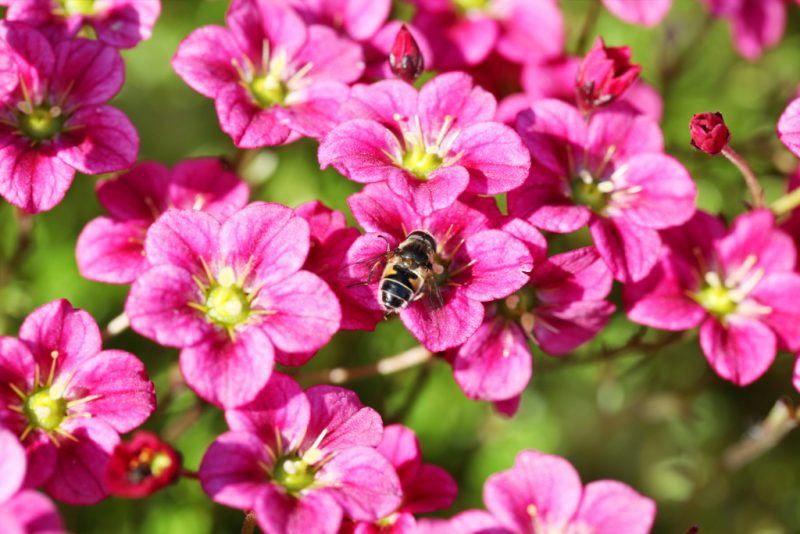
Flowering ground cover perennials:
- clove-grass;
- saxifrage;
- periwinkle;
- bloodroot;
- thrift;
- verbena and others
Stonecrops are "classic" groundcover flowering perennials. The color of the corollas in different species of this genus: yellow, white, pink, purple. Stonecrops prefer sunny areas with dry soils.
Bulb flowers
Plants that store nutrients in underground organs usually bloom in early spring. Then crocuses, hyacinths, tulips and daffodils require a period of rest. Caring for onion plants is not burdensome, and their flowers are usually larger and brighter compared to summer trees.
- Golden crocosmia or Japanese gladiolus blooms for a long time and abundantly in open flowerbeds. Graceful star-funnel corollas are collected in loose inflorescences. Crocosmia corms are planted simultaneously with gladioli.
- Dutch irises are bulbous flowers that differ in height and color. Petals can be yellow, white, lilac, blue, blue, burgundy and purple. One plant blooms for a relatively short time, but you can choose varieties with different periods of bud blooming. Foliage of bulbous irises does not lose decorativeness after flowering.
Variety of colors of perennials depending on size
Dwarf forms of perennials loved by them are very popular: daylilies, phloxes, irises. The height of low-growing varieties and hybrids is 20-30 cm. They are used in landscape design along with ground cover plants. Perennials of medium height extend to 40-60 cm. These are plants that are universal in application. Tall perennials are successfully combined in mixborders with dwarf trees and shrubs.
Undersized
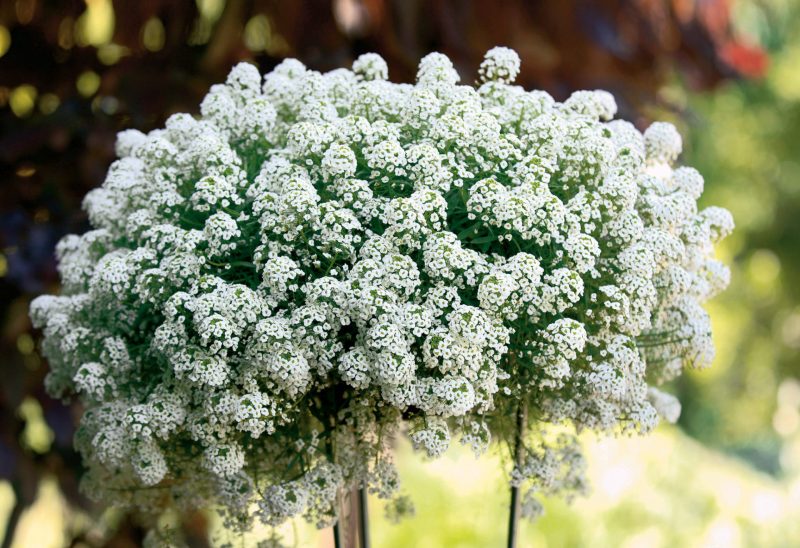
- Alyssum rocky is one of the popular perennials for alpine hills, rockeries and other types of flower beds. The curtains of a miniature plant look attractive due to the bright flowers above the delicate green leaves. Favorable neighborhood for alissum: undersized cloves, phlox, violets, irises, marigolds.
- Phlox spread “Chattahuchi” is a herbaceous perennial up to 30 cm high. Elegant flowers of delicate lavender color are collected in racemose inflorescences. Creeping shoots grow and form an elegant curtain. Well-lit areas and partial shade are suitable for phloxam.
- Periwinkles are creeping plants with a long flowering period. Petals of natural species are blue in color. Varieties with white, pink and lilac flowers, forms with a double whisk are bred.
Medium
Perennial asters and small petals are two groups of undemanding plants that bloom from early summer to autumn.
- Alpine astra reaches a height of 60 cm. Inflorescences are quite large (4-5 cm in diameter). The color of the petals is mainly pink or lilac, the core is yellow.
- Alliums or decorative bows are unpretentious plants that retain a decorative effect for a long time. From the end of spring, a thin stalk crowned with a spherical umbrella inflorescence grows from a bunch of elongated leaves. Allium decorative bows are well combined with iris, aquilegia, peonies, roses, decorative herbs.
- Hybrid daylily buds, depending on the species and variety, appear in May or early summer. Flowering with proper care continues until the fall. The color of the corollas strikes with an abundance of shades and color transitions. The number of buds on one peduncle reaches 50: they bloom and live for a day, new ones appear to replace them.
Tall
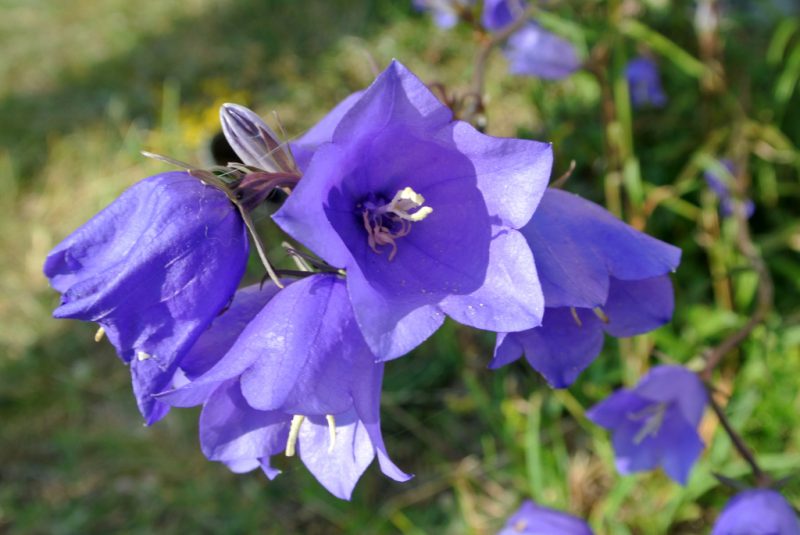
- A bell is a plant gaining a “second wind” due to the emergence of new varieties. Hybrids are found in flowerbeds with simple and double flowers of blue, white, blue, lilac or lilac color. Bells should be grown in a well-lit area without stagnation of water.
- Aquilegia - a garden plant, also known as the "catchment". Spreading bushes reach a height of 40–80 cm, flowers of unusual shape have a diameter of 3–8 cm. Corollas are drooping, bell-shaped, on long pedicels. Coloring, as a rule, two- or three-color.
- Perennial gaillardia (sun chamomile, fire wheel) is a dense bush with elongated leaves and thin peduncles crowned with single yellow-red baskets with a dark core. Marginal reed flowers form one row or several. Gailardia is appreciated for its long flowering, resistance to low and high temperatures.
- Leucanthemum (garden chamomile) is a traditional symbol of Russian open spaces and a rural landscape. The height of garden forms is more than 50 cm. Simple and terry inflorescences-baskets are smaller with a lack of moisture and nutrients in the soil.
No less popular are other tall perennials for flower beds: paniculata phlox, cornflower and others.
Plants for spring planting
You can plant ephemeroid bulbs dug in the fall. They bloom in good light and moist, and in summer go into a state of rest. The aerial part of most herbaceous perennials dies in the winter, only underground organs are preserved.
Plants for planting in spring:
- tulips;
- daffodils;
- hyacinths;
- primrose
- Crocuses
- Muscari
- phlox;
- peonies.
Bulbous and rhizome irises, early daylily varieties, dicentres, and incense are planted in spring. Keep in mind the requirements of these plants for lighting and moisture.
Summer and beautiful
Herbaceous perennials are planted in temperate regions in spring or early fall. Planting and replanting plants in the summer has advantages and disadvantages. You can quickly create a beautiful flowerbed, but you will need to water, mulch and shade more often. To minimize the risk, you should choose strong seedlings with a developed root system and a lump of earth.
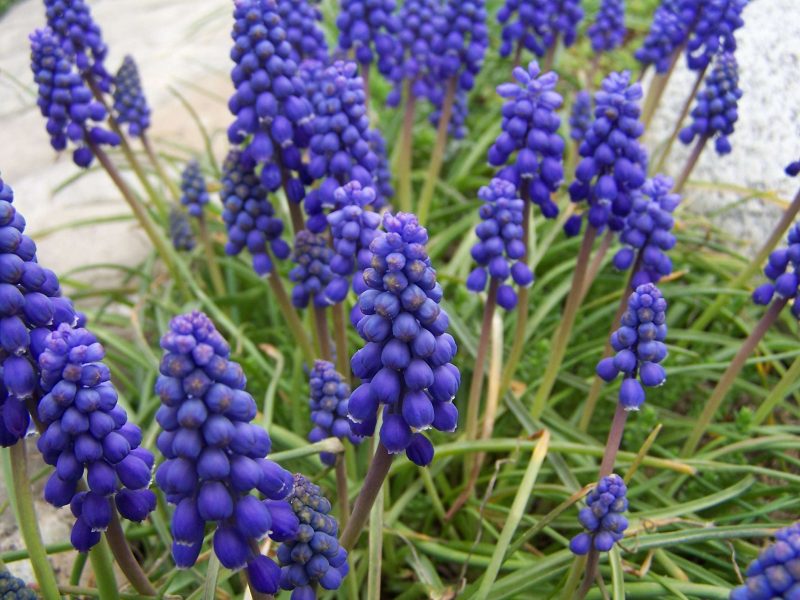
If there was a need to plant plants in the summer, then you need to protect the roots and the aerial part from drying out.
In the summer after flowering, primroses, hazel grouse, and muscari are transplanted. You can divide rhizome irises, awl-shaped phlox. You should not disturb summer peonies, chrysanthemums, perennial asters, stonecrops.
Perennials for planting in the fall
September is a favorable time for planting crocuses, scylla, muscari, Pushkinia, hyacinths, daffodils and tulips. These plants are used for distillation, so part of the bulbs can be placed in containers and stored in the room until December, and then put on the windowsill. In the fall, transplanted and shared with the host, perennial asters, chrysanthemums, nyvyanik, astilba.
You can sow:
- delphinium;
- bell;
- gypsophila;
- aquilegia;
- to the center;
- primrose.
When choosing a deadline, the climatic conditions of your region should be taken into account. Sowing and transplanting should be carried out before the first frosts.
Most perennials grown from seeds bloom in the second or third year.
Spicy aromatic unpretentious flowers for a summer residence
Spicy, medicinal and fragrant herbs are many. Some are famous for beautiful flowers, others have interesting leaves. The general fact is that these plants are used in medicine, cooking, and households.
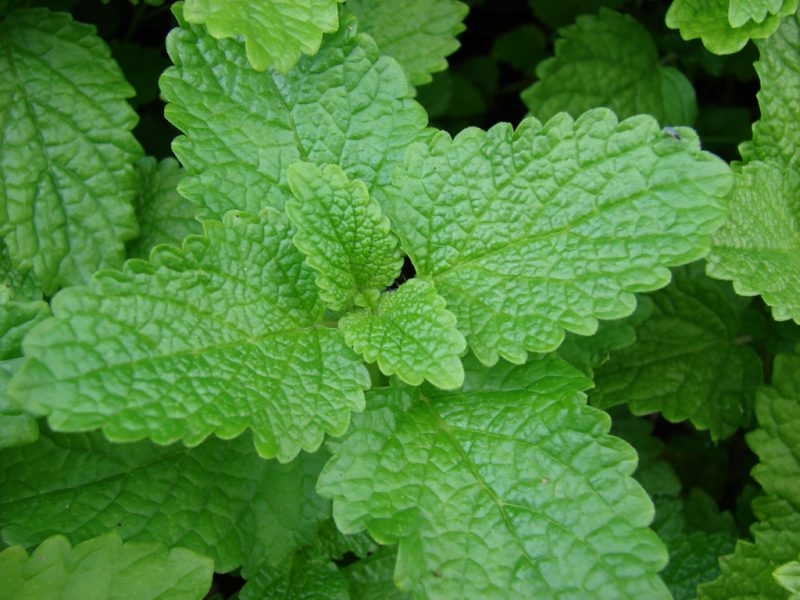
Spicy aromatic flowers for growing in the country:
- lemon balm (lemon mint);
- clary;
- oregano (oregano);
- thyme (thyme);
- peppermint;
- fennel;
- lavender;
- hyssop and others
Many aromatic plants are valued not only for medicinal and nutritional properties. Sometimes they are not inferior in beauty to decorative perennials. Tender lilac inflorescences and pink brushes of oregano look tender. Lilac-pink “candles” of clary sage are visible from afar. Such flowering plants will decorate the garden in the country and will benefit the owners.
If desired, and the availability of time, summer residents can combine summers and perennials in the flowerbed. But this is a more troublesome task, since more attention will need to be paid to soil preparation, selection of assortment and flower care.


